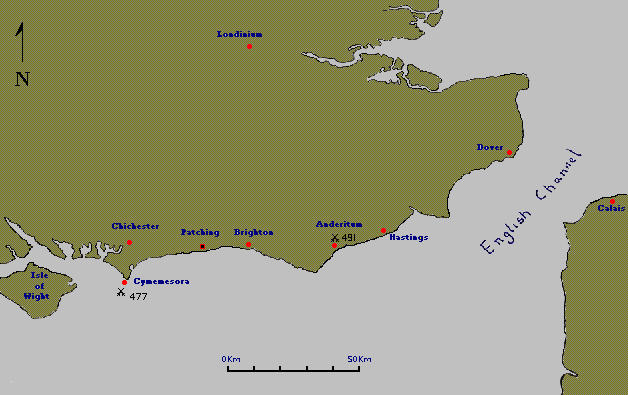 |
| TreasureRealm Home | The Patching Hoard | Other Countries | Coins for Sale |
The Patching Hoard
History Surrounding the Hoard
Regarding the late date of this hoard (which was probably deposited sometime after 475), there are several reasons why this should not be all that outstanding. With the evacuation of Roman legions in 410, Britain did not automatically and immediately fall into a Dark Ages. The large towns continued to exist the way they had prior to the Roman withdrawal.
And, though there was little or no Roman military presence on the island, there was a Romano-British administration that existed in places, and travel and trade continued with the mainland. With no steady influx of new coin to the island, silver coins that already were there were clipped for change etc. This is shown by the fact that 13 of the coins in the hoard are either broken or clipped.
Use of coinage ceased on the island by the middle of the 5th century, but this does not present a problem; all but two of the coins in this hoard are from before 455. The two minted after 455 are gold solidi, which would not have circulated as coin anyway. The Visigothic issues of Valentinian III are in a high state of preservation and obviously did not see much circulation at all. [Condition of the post 455 gold coins, do they indicate any use? Will need additional images for this]
This hoard may have been put together by someone who had come to the island sometime in the 460's (bringing with him some Ravennese gold) and deposited it during the strife of that time.
Looking at the Anglo-Saxon Chronicles shows several cases of travel to and from the mainland; Britain was not an isolated land. With invading Picts, and Teutons being invited to the island to counter the Picts, there was also no shortage of reasons to prompt a hoarding. Perhaps even, this hoard was deposited by some Teuton prior to battle--it could represent a combination of captured booty and pieces brought from Gaul, and would explain the presence of late Visigothic gold.
From the Anglo-Saxon Chronicle (Parker Chronicle, Garmonsway translation):
AN cccclxxvii Her cuom ælle on Breten lond, & his iii suna. Cymen,
& Wlencing, & Cissa. mid iii scipum, on þa stowe þe is
nemned Cymenes ora, & þær ofslogon monige Wealas, &
sume on fleame bedrifon on þone wudu þe is genemned Andred es
leage.
The place called Cymenesora (or Cymen's Shore) has been identified with the Owers south of Selsey Bill (see map) and is now underwater. It is approximately 30 kilometers to the west of Patching. The wood, often called simply the Weald, was a large expanse of forest running from Kent to the area near Winchester, and from a small strip along the southern coast almost to the Thames. The survivors of the battle near Cymenesora fled into the wood and presumably to the fortress of Anderitum (see below) for refuge. The forest Andredesleag gets its name from this fort. Those in flight would have passed right through Patching while pursued by AElle's men.

From the Chronicle:
AN cccclxxxv Her ælle gefeaht wiþ Walas neah
Mearcrædesburnan stæÐe.
While still unidentified, Mearcroedesburna was a stream or river that served as somewhat of a marker or boundary between the men of AElle and the land of Kent. That a battle took place along this stream or river indicates that AElle's forces continued to move east after their landing and would have passed through the land where Patching now is. [previous failure of AElle to take the city of Chichester]
Again, from the Chronicle:
AN ccccxci Her ælle & Cissa ymbsæton Andredescester,
& ofslogon alle þa þe þærinne eardedon, ne
wearþ þær forþon an Bret to lafe;
Andredescester is the Roman fort of Anderitum at what is now Pevensey. This is located some 50 kilometers to the east of Patching (see map).
Any of these events would warrent the placing of belongings into the ground for safe-keeping. The events of 477 may be more likely to have prompted the Patching Hoard, but regardless, it is shown that the period from the time the last coin in the hoard was minted until the 490's, this region was very unsettled and that this hoard was deposited then is very plausible.
We may not know the exact who, why and when surrounding the depositing of this hoard, but there are no shortage of explanations for its existance.
News Release | Hoard Inventory | Details-Analyses | History

Custom Search
|
Terms of Use - Privacy Policy - Contact - Home
© 1996-2021 TreasureRealm